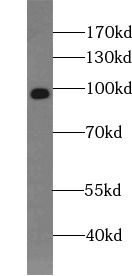Products
ENTPD1 antibody
| Synonyms: | Ectonucleoside triphosphate diphosphohydrolase 1|ATP diphosphohydrolase (ATP-DPH antibody, ATPDase)|Ecto-ATP diphosphohydrolase 1 (Ecto-ATPDase 1 antibody, Ecto-ATPase 1)|Ecto-apyrase|Lymphoid cell activation antigen|Nucleoside triphosphate diphosphohydrolase 1 (NTPDase1)|ENTPD1|CD39 antibody | ||
| Catalogue No.: | FNab01474 | Reactivity: | Human, Mouse, Rat |
| Host: | Rabbit | Tested Application: | ELISA, WB, IHC, FC, IP |
| Clonality: | polyclonal | Isotype: | IgG |
| Size | Price |
|---|---|
| 100µg | Inquiry |
- SPECIFICATIONS
- FIGURES
- CONDITIONS
- FAQS
- Product Name
- ENTPD1 antibody
- Catalogue No.
- FNab01474
- Size
- 100μg
- Form
- liquid
- Purification
- Immunogen affinity purified
- Purity
- ≥95% as determined by SDS-PAGE
- Clonality
- polyclonal
- Isotype
- IgG
- Storage
- PBS with 0.02% sodium azide and 50% glycerol pH 7.3, -20℃ for 12 months(Avoid repeated freeze / thaw cycles.)
- Immunogen
- ectonucleoside triphosphate diphosphohydrolase 1
- Alternative Names
- Ectonucleoside triphosphate diphosphohydrolase 1|ATP diphosphohydrolase (ATP-DPH antibody, ATPDase)|Ecto-ATP diphosphohydrolase 1 (Ecto-ATPDase 1 antibody, Ecto-ATPase 1)|Ecto-apyrase|Lymphoid cell activation antigen|Nucleoside triphosphate diphosphohydrolase 1 (NTPDase1)|ENTPD1|CD39 antibody
- UniProt ID
- P49961
- Observed MW
- 75-95 kDa
- Tested Applications
- ELISA, WB, IHC, FC, IP
- Recommended dilution
- WB: 1:500-1:2000; IP: 1:200-1:1000; IHC: 1:20-1:200
 Jurkat cells were subjected to SDS PAGE followed by western blot with FNab01474(ENTPD1 antibody) at dilution of 1:500
Jurkat cells were subjected to SDS PAGE followed by western blot with FNab01474(ENTPD1 antibody) at dilution of 1:500
 IP Result of anti-ENTPD1 (IP:FNab01474, 4ug; Detection:FNab01474 1:800) with mouse liver tissue lysate 4000ug.
IP Result of anti-ENTPD1 (IP:FNab01474, 4ug; Detection:FNab01474 1:800) with mouse liver tissue lysate 4000ug.
 Immunohistochemistry of paraffin-embedded human tonsillitis using FNab01474(ENTPD1 antibody) at dilution of 1:50
Immunohistochemistry of paraffin-embedded human tonsillitis using FNab01474(ENTPD1 antibody) at dilution of 1:50
- Background
- ENTPD1(Ectonucleoside triphosphate diphosphohydrolase 1) is also named as CD39, NTPDase 1, Ecto-ATPDase 1 and belongs to the GDA1/CD39 NTPase family. In the nervous system, it can hydrolyze ATP and other nucleotides to regulate purinergic neurotransmission.It is a noncovalent tetrameric protein and that detergent inhibition of enzymatic activity is caused by dissociation of ectoapyrase tetramers into monomers(PMID: 9733785).And it is a 70-to 100-kDa protein that is heavily N-glycosylated(PMID:7930580). It has 3 isoforms produced by alternative splicing. CD39 preferentially occurred as a dimer that could be dissociated into monomeric forms.(PMID: 12694193). The soluble isoform of CD39(38-478 amino acid) locates to the extracellular part and FNab01474 recognizes both the 3 isoforms and soluble form of CD39(38-478aa) molecule.
How many times can antibodies be recycled?
First, usually it's not suggested to recycle antibodies. After use, buffer system of antibodies has changed. The storage condition of recycled antibodies for different customers also varies. Thus, the performance efficiency of recycled antibodies can’t be guaranteed. Besides, FineTest ever conducted the antibody recycling assay. Assay results show recycling times of different antibodies also varies. Usually, higher antibody titer allows more repeated use. Customers can determine based on experimental requirements.
Notes: After incubation, we recycle rest antibodies to centrifuge tube and store at 4℃. High titer antibodies can be stored for a minimum of one week. Reuse about three times.
What are components of FineTest antibody buffer?
Components of FineTest antibody buffer are usually PBS with proclin300 or sodium azide, BSA, 50% glycerol. Common preservative is proclin300 or sodium azide, which is widely applied in the lab and industry.
How about the storage temperature and duration of FineTest antibodies?
Most antibodies are stored at -20℃. Directly-labeled flow cytometry antibodies should be stored at 2 - 8℃. The shelf life is one year. If after sales issues for purchased antibodies appear, return or replacement is available. Usually, antibodies can be still used after the one-year warranty. We can offer technical support services.
Is dilution required for FineTest antibodies? What’s the dilute solution?
Directly-labeled flow cytometry antibodies are ready-to-use without dilution. Other antibodies are usually concentrated. Follow the dilution ratio suggested in the manual. Dilute solution for different experiments also varies. Common antibody dilution buffers are acceptable(e.g. PBST, TBST, antibody blocking buffer).
How to retrieve antibodies for immunohistochemistry?
Common retrieval buffers: Tris-EDTA Buffer(pH 9.0); Citrate Buffer(pH 6.0)
Heat induced antibody retrieval:
Method 1: Water-bath heating: Put the beaker with retrieval buffer and slide in the boiling water bath. Keep the boiling state for 15min. Naturally cool to room temperature;
Method 2: Microwave retrieval: Put the beaker with retrieval buffer and slide in the microwave oven. Heat at high power for 5min, Switch OFF for 3min, Heat at medium power for 5min. Naturally cool to room temperature.
How to choose secondary antibodies?
(1) Secondary antibodies react with primary antibodies. Thus, secondary antibodies should be against host species of primary antibodies. E.g. If the primary antibody is derived from rabbit, the relevant secondary antibody should be against rabbit. E.g. goat anti rabbit or donkey anti rabbit.
(2) Choose secondary antibody conjugates according to the experimental type, e.g. ELISA, WB, IHC etc. Common enzyme conjugated secondary antibodies are labelled by HRP, AP etc. Fluorescin or dye labelled secondary antibodies are applied in immunofluorescence and flow cytometry(e.g. FITC, Cy3).
